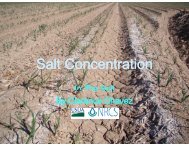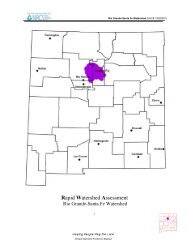SAMPLING VEGETATION ATTRIBUTES - New Mexico NRCS - US ...
SAMPLING VEGETATION ATTRIBUTES - New Mexico NRCS - US ...
SAMPLING VEGETATION ATTRIBUTES - New Mexico NRCS - US ...
You also want an ePaper? Increase the reach of your titles
YUMPU automatically turns print PDFs into web optimized ePapers that Google loves.
4<br />
INTRODUCTION<br />
represent the “pulse” of the rangeland. Proper selection of key areas requires<br />
appropriate stratification. Statistical inference can only be applied to the stratification<br />
unit.<br />
a Selecting Key Areas The most important factors to consider when selecting<br />
key areas are the management objectives found in land use plans, coordinated<br />
resource management plans, and/or activity plans. An interdisciplinary team<br />
should be used to select these areas. In addition, permittees, lessees, and other<br />
interested publics should be invited to participate, as appropriate, in selecting<br />
key areas. Poor information resulting from improper selection of key areas leads<br />
to misguided decisions and improper management.<br />
b Criteria for Selecting Key Areas The following are some criteria that should<br />
be considered in selecting key areas. A key area:<br />
• Should be representative of the stratum in which it is located.<br />
• Should be located within a single ecological site and plant community.<br />
• Should contain the key species where the key species concept is used.<br />
• Should be capable of and likely to show a response to management actions.<br />
This response should be indicative of the response that is occurring on the<br />
stratum.<br />
c Number of Key Areas The number of key areas selected to represent a stratum<br />
ideally depends on the size of the stratum and on data needs. However, the<br />
number of areas may ultimately be limited by funding and personnel constraints.<br />
d Objectives Objectives should be developed so that they are specific to the key<br />
area. Monitoring studies can then be designed to determine if these objectives are<br />
being met.<br />
e Mapping Key Areas Key areas should be accurately delineated on aerial<br />
photos and/or maps. Mapping of key areas will provide a permanent record of<br />
their location.<br />
E. Key Species Key species are generally an important component of a plant<br />
community. Key species serve as indicators of change and may or may not be forage<br />
species. More than one key species may be selected for a stratum, depending on<br />
objectives and data needs. In some cases, problem plants (poisonous, etc.) may be<br />
selected as key species. Key species may change from season to season.<br />
The process used to select key species should be documented. Documentation should<br />
include the management objectives, the criteria used for selecting species, and the kinds<br />
of comparisons or interpretations expected to be made from them.<br />
a Selecting Key Species Selection of key species should be tied directly to<br />
objectives in land-use plans, coordinated resource management plans, and<br />
activity plans. This selection depends upon the plant species in the present<br />
plant community, the present ecological status, and the potential natural communities<br />
for the specific sites. An interdisciplinary team should be used in




